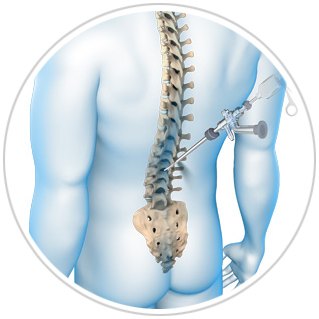-
Muscle and Bone
Preservation -
Quicker Return to Work
-
Less Pain
-
Faster Recovery
-
Lower Risk of Infection
-
Precise targeting of
the problem area -
Smaller Incision
What is Endoscopic Spine Surgery?
Endoscopic spine surgery utilizes a special camera (endoscope) and specialized micro-instruments to target specific problem areas to minimize trauma to the body and allow you to heal and recover faster than more invasive approaches. Traditional spine surgical approaches include “open” or “tubular” based techniques which require larger incisions, more muscle dissection, more blood loss and a higher incidence of some complications. All of these techniques are effective treatment options and only differ in HOW we treat and not WHAT we treat as spine surgeons.
What can it be used for?
The goals of traditional and endoscopic spine surgery remain the same and depend on the problem that is being treated. Endoscopic spine surgery is simply a less disruptive way of addressing a problem and can be used to
accomplish a variety of surgical goals such as taking pressure off of nerves (laminectomy, microdiscectomy, foraminotomy), reduce pain from arthritic joints (radiofrequency ablation of the facet joints and SI joints) and perform fusion (link two arthritic vertebrae together). If you have pain in your neck, back, arms or legs, schedule a visit to determine if your condition can be treated with endoscopic spine surgery.
Is endoscopic spine surgery the same as “laser spine surgery”?
There is no such thing as “laser spine surgery.” The laser is just a tool, similar in function to a radiofrequency probe (RF probe) that can be used to shrink and remove tissue that is causing compression. A laser or RF probe can be used as a tool to accomplish a specific task in endoscopic spine surgery. Don’t be fooled by any gimmicks – a laser is not a critical part of the surgery; more importantly, pain and recovery after surgery depends on the amount of dissection and trauma the body has to undergo for the surgeon to access the problem area
Am I a Candidate?
Click here to schedule a visit with Dr. Hasan to determine if you may be a candidate for endoscopic spine surgery. It is often useful to have copies of any spine imaging (MRI, XR) when determining if you are a candidate. Please bring any copies in a CD format to review with Dr. Hasan at your office visit. Don’t have any imaging? No problem, at Webster Orthopedics we have access to the latest imaging technologies to help diagnose your medical condition.
Revolutionizing the Landscape of Spine Surgery
Dr. Hasan is the first spine surgeon in the United States to complete an additional fellowship training program in endoscopic spine surgical techniques and has authored numerous textbook chapters and scientific articles on endoscopic spine surgery. Dr. Hasan is passionate about elevating the standard we provide our spine patients and has given numerous lectures on endoscopic spine surgery and teaches surgeons from around the world. Click here to read Dr. Hasan’s scientific publication on the topic of endoscopic spine surgery and how there are significant benefits with this approach over traditional spine surgery techniques.
Surgical Technique Videos
-
Lumbar Disc Herniation
-
Lumbar Laminectomy
-
Facet Joint Endoscopic Neurotomy
Links
- The joimax® media center offers videos that showcase patient reports after surgery, statements from surgeons, animation videos, which explain thejoimax® methods as well as recordings from live disc surgeries. (click here)
- For more media content please visit their youtube channel: https://www.youtube.com/user/joimaxcom/feed


